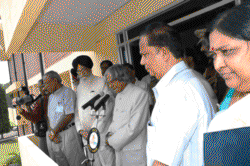Archives
Chandrayaan en route to benefit India
A jubilant Chairman of the ISRO G Madhavan Nair is not wrong when he says, “We have traveled all the way to the Moon. It has been favourable to us. MIP has given the Moon to India.” It is not out of place to mention that the day for the landing of the MIP was chosen on November 14 which is the 119th birth anniversary of the first Prime Minister of India Pandit Jawaharlal Nehru which is observed as Children’s Day across the nation.
The primary objective of the MIP is to demonstrate the technology required for landing a probe at the predestinated location on the Moon. The probe will help qualify some of the technologies related to future soft landing missions.
It is really being described as an inspirational and momentous achievement for space scientists to take the country to a leadership position in space probes and technology. It must be recalled that the mission which was first announced by the then Prime Minister Atal Bihari Vajpayee in his Independence Day Speech from the ramparts of the historic Red Fort on August 15,2003, cost the nation 86 million USD which is much less than the price of a Boeing 737 aircraft! Such an exercise has not been accomplished with a very high degree of success by other countries. It is creditable that it is an achievement in that the ISRO has been successful in its very first attempt. For some other some space agencies, success in sending missions to the Moon came after initial disasters at the cost of their national exchequers.

After the commendable success achieved, ISRO is justified in deciding to go ahead with the Chandrayaan II Mission in 2012, the second mission to the Moon which will have a lander and a robot that will probe the Moon’s surface in greater detail. ISRO is keen on undertaking other missions to Mars and the Sun, knowledge about which remains minimal. The Government should not hesitate to provide adequate funds for the proposed projects intended to considerably add to our scientific knowledge and help India remain in the forefront of science and technology. The missions will enrich our knowledge about the solar system and the planet and also enable humankind to manage the planetary resources much better than at present.
Its success will open up tremendous business opportunities for ISRO. It will lead to sophistication of the Indian space system like INSAT and IRS and help better communication systems, improve forecasting weather condition, agricultural and allied activities as well as Research and Development (R&D) in various sectors of the economy. India will be in a position to produce better and more sophisticated satellites which could be used to improve the quality of life for the people and the country can maybe sell these in the international market where there is a great demand for them. The success of Chandrayaan I is also significant since it has been conceived and undertaken in the spirit of international cooperation among the space scientific community. While the launch vehicle and the lunar orbiter have been indigenously built, Russia has provided the landing module and the Moon Rover to bring soil from the moon to the earth.
Applauding the achievement, former President of India, Dr APJ Abdul Kalam, a noted rocket scientists who had conceived the MIP, said that the landing of the MIP will kindle a dream in all children. In one and a half decades, “I would like to see an Indian on the moon. The moon will be a strategic and economic complex for India in the near future,” he said.
This is the major objective of India’s first ever odyssey to the Moon and there is no reason why it will not be successful. The Indian political establishment, irrespective of ideologies, should extend unstinted cooperation to the scientific community without any interference in their mission if they are interested in advancing the country in the sphere of science and technology.
By 2020 when the United States and Russia plan to set up bases on the Moon, India definitely will be in a position to put a human being on the earth’s nearest satellite. Hats off to the ISRO!!!

